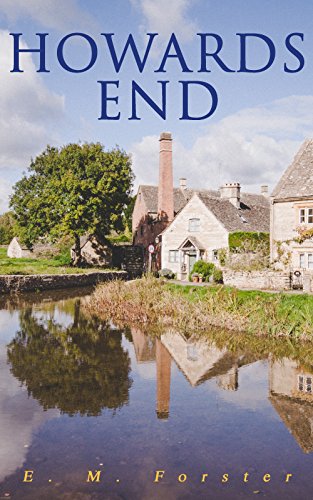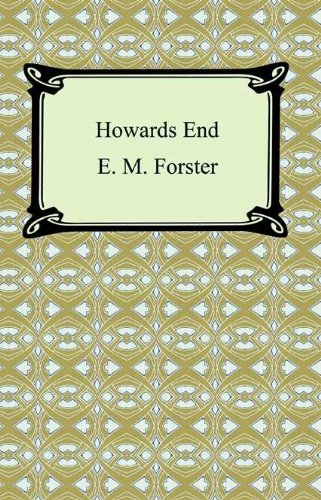-
Howards End
E. M. Forster
eBook (e-artnow, June 5, 2018)This carefully crafted ebook: "Howards End" is formatted for your eReader with a functional and detailed table of contents. The story revolves around three families in England at the beginning of the 20th century: the Wilcoxes, rich capitalists with a fortune made in the colonies; the half-German Schlegel siblings (Margaret, Helen, and Tibby), whose cultural pursuits have much in common with the Bloomsbury Group; and the Basts, an impoverished young couple from a lower-class background. As fate would have it, their lives are going to be intertwined in such a manner that the secret passions and flying tempers would bring each of the family to the verge of ruin. Can they survive this vortex or will they be ruined forever?
-
Howards End
E.M. Forster, Nadia May, Blackstone Audio, Inc.
Audiobook (Blackstone Audio, Inc., Dec. 15, 1999)A vibrant portrait of Edwardian England, Howards End examines personal relationships and conflicting values. The Schlegel sisters, Margaret and Helen, and their brother, Tibby, place their values in civilized living, music, literature, and conversation with their friends. The Wilcoxes, Henry and his children Charles, Paul, and Evie, are concerned with the business side of life and distrust emotions and imagination. Howards End, a charming country house in Hertfordshire that belonged to Henry Wilcox's first wife, becomes the object of an inheritance dispute between the Wilcox family and the Schlegel sisters. Through romantic entanglements, disappearing wills, and sudden tragedy, the conflict over the house emerges as a symbolic struggle for England's very future.
-
Howards End
E. M. Forster
Paperback (Dover Publications, Oct. 29, 2002)The self-interested disregard of a dying woman's bequest, an impulsive girl's attempt to help an impoverished clerk, and the marriage between an idealist and a materialist — all intersect at a Hertfordshire estate called Howards End. The fate of this beloved country home symbolizes the future of England itself in E. M. Forster's exploration of social, economic, and philosophical trends, as exemplified by three families: the Schlegels, symbolizing the idealistic and intellectual aspect of the upper classes; the Wilcoxes, representing upper-class pragmatism and materialism; and the Basts, embodying the aspirations of the lower classes. Published in 1910, Howards End won international acclaim for its insightful portrait of English life during the post-Victorian era.
-
Howards End
E. M. Forster
eBook (Digireads.com, March 31, 2004)"Howards End" is E. M. Forster's classic story of the varying struggles of members of different strata of the English middle class. The story centers around three families; the Wilcoxes, who made their fortune in the African colonies; the Schlegels, three siblings who represent the intellectual bourgeoisie; and the Basts, a young struggling lower middle-class couple. "Howards End", one of Forster's greatest works, is a classic dramatization of the differences in life amongst the English middle class.
-
Howards End
E. M. Forster, Alfred Kazin
Hardcover (Everyman's Library, Nov. 26, 1991)First published in 1910, Howards End is the novel that earned E. M. Forster recognition as a major writer. Soon to be a limited series on Starz.At its heart lie two families—the wealthy and business-minded Wilcoxes and the cultured and idealistic Schlegels. When the beautiful and independent Helen Schlegel begins an impetuous affair with the ardent Paul Wilcox, a series of events is sparked—some very funny, some very tragic—that results in a dispute over who will inherit Howards End, the Wilcoxes' charming country home. As much about the clash between individual wills as the clash between the sexes and the classes, Howards End is a novel whose central tenet, "Only connect," remains a powerful prescription for modern life.Introduction by Alfred Kazan(Book Jacket Status: Not Jacketed)
-
Howards End
E. M. Forster, David Lodge
Paperback (Penguin Classics, April 1, 2000)E. M. Forster's meticulously observed drama of class warfare exploring the conflict inherent within English society—the inspiration for the award-winning two-part play The Inheritance, now on Broadway"Only connect..." A chance acquaintance brings together the preposterous bourgeois Wilcox family and the clever, cultured and idealistic Schlegel sisters. As clear-eyed Margaret develops a friendship with Mrs Wilcox, the impetuous Helen brings into their midst a young bank clerk named Leonard Bast, who lives at the edge of poverty and ruin. When Mrs Wilcox dies, her family discovers that she wants to leave her country home, Howards End, to Margaret. Thus as Forster sets in motion a chain of events that will entangle three different families, he brilliantly portrays their aspirations to personal and social harmony. David Lodge's introduction provides an absorbing and eloquent overture to the 1910 novel that established Forster's reputation as an important writer, and that he himself later referred to as "my best novel." This edition also contains a note on the text, suggestions for further reading, and explanatory notes.For more than seventy years, Penguin has been the leading publisher of classic literature in the English-speaking world. With more than 1,700 titles, Penguin Classics represents a global bookshelf of the best works throughout history and across genres and disciplines. Readers trust the series to provide authoritative texts enhanced by introductions and notes by distinguished scholars and contemporary authors, as well as up-to-date translations by award-winning translators.
-
Howards End
E.M. Forster
Mass Market Paperback (Bantam Classics, Oct. 1, 1985)What makes this masterpiece a pure delight for contemporary readers is its vibrant portrait of life in Edwardian England, and the wonderful characters who inhabit the charming old country house in Hertfordshire called Howards End. This cozy house becomes the object of an inheritance dispute between the upright conservative Wilcox family and the Schlegel sisters, Margaret and Helen, sensitive and intuitive women loved by men willing to leap wide social barriers to fulfill their ardor. Through romantic entanglements, disappearing wills, and sudden tragedy, the conflict over the house emerges as a symbolic struggle for England’s future. Rich with the tradition, spirit, and wit distinctively English, Howards End is a remarkable novel of rare insight and understanding. As in his celebrated A Passage to India, E. M. Forster brings to vivid life a country and an era through the destinies of his unforgettable characters.
-
Howards End
E. M. Forster
Paperback (Digireads.com Publishing, Dec. 26, 2017)First published in 1910, “Howards End” is E. M. Forster’s classic story regarding social conventions of different strata of English society at the end of the 19th century. The story centers around three families; the Wilcoxes, a wealthy family who made their fortune in the African colonies; the Schlegels, three siblings, Margaret, Helen, and Tibby, who represent the intellectual bourgeoisie; and the Basts, a young struggling couple from a lower class background. The Schlegels are lively socialites whose spirited and active lifestyles bring them by chance into contact with the Wilcoxes and the Basts. Through the entanglement between these three families, Forster masterfully depicts the struggle between the upper and lower classes that would dominate England at the end of the 19th century. Forster drew upon memories of his childhood home, Rooks Nest in Hertfordshire, for the titular Howards End, a country estate of the Wilcoxes where part of the story takes place, and whose ownership comes into question when the Wilcox matriarch, Ruth, makes a death-bed bequeath of the estate to Margaret Schlegel. The fate of Howards End, and the lives of the family’s affiliated with it, is brilliantly represented by Forster as a parallel to the fate of English Society itself at the turn of the century. This edition is printed on premium acid-free paper.
-
Howards End
E. M. Forster
eBook (Andura Publishing, Feb. 1, 2020)The classic book from E. M. Forster now adapted for television.
-
Howards End
E. M. Forster
eBook (Andura Publishing, June 10, 2017)Howards End by E. M. Forster
-
Howards End
E. M. Forster
eBook (Andura Publishing, Feb. 1, 2020)The classic book from E. M. Forster now adapted for television.
-
Howards End
E.M. Forster
eBook (Andura Publishing, Nov. 30, 2010)The Schlegels are intellectuals, devotees of art and literature. The Wilcoxes are practical and materialistic, leading lives of "telegrams and anger." When the elder Mrs. Wilcox dies and her family discovers she has left their country home—Howards End—to one of the Schlegel sisters, a crisis between the two families is precipitated that takes years to resolve. Howards End is a symbolic exploration of the social, economic, and intellectual forces at work in England in the years preceding World War I, a time when vast social changes were occurring. In the Schlegels and the Wilcoxes, Forster perfectly embodies the competing idealism and materialism of the upper classes, while the conflict over the ownership of Howards End represents the struggle for possession of the country’s future. As critic Lionel Trilling once noted, the novel asks, "Who shall inherit England?" Forster refuses to take sides in this conflict. Instead he poses one of the book’s central questions: In a changing modern society, what should be the relation between the inner and outer life, between the world of the intellect and the world of business? Can they ever, as Forster urges, "only connect"?Book ExcerptOne may as well begin with Helen’s letters to her sister.Dearest Meg,It isn’t going to be what we expected. It is old and little, and altogether delightful—red brick. We can scarcely pack in as it is, and the dear knows what will happen when Paul (younger son) arrives to–morrow. From hall you go right or left into dining–room or drawing–room. Hall itself is practically a room. You open another door in it, and there are the stairs going up in a sort of tunnel to the first–floor. Three bed–rooms in a row there, and three attics in a row above. That isn’t all the house really, but it’s all that one notices—nine windows as you look up from the front garden.